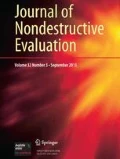Abstract
This paper describes a system model for the ultrasonic inspection of smooth planar cracks in ferritic steel, using pulse-echo probes. The model predicts the echo amplitudes and ranges as functions of the probe position. It is applied to problems of procedure design, assessment, and technical justification on power station plant. The model is implemented as a suite of versatile and user-friendly computer codes, suitable for use by practical NDT engineers, and is supported by a comprehensive user manual. The paper describes the principles of the model and gives examples of its application to power plant problems. Illustrations are also given of the extensive validation which the model has undergone through comparison with experiment.
Similar content being viewed by others
References
J. A. Ogilvy, Computerised ultrasonic ray tracing in austenitic steel,NDT Int. 1867–77 (1985).
G. H. Hunter and T. G. Fenney, Computer graphics for ultrasonic data interpretation, in Non-destructive Testing (Proc. 4th European Conf. on NDT, held London, Sept. 1987), ed. J. M. Farley and R. W. Nichols, eds. (Pergamon Press, Oxford, 1988), Vol. 1, pp. 612–626.
J. M. Coffey, R. K. Chapman, and D. J. Hanstock, The Ultrasonic Detectability of a Postulated ‘Worst Case’ Flaw in a PWR Vessel, CEGB Report NWR/SSD/82/0045/R (1982).
M. J. Whittle, CEGB Proof of Evidence on Non-destructive Testing, for Sizewell “B” Power Station Public Inquiry, Central Electricity Generating Board, Proof P13. (1982).
R. K. Chapman, An integrated model of ultrasonic NDT and its practical application, in Mathematical Modelling in Non-destructive Testing” (Proceedings of conference held Cambridge, Sept. 1986), M. Blakemore and G. A. Georgiou, eds. (Clarendon Press, Oxford, 1988), pp. 209–232.
R. K. Chapman, Review of practical developments in theoretical models of ultrasonic NDT, in NDT-86 (Proc. 21st Annual Brit. Conf. on NDT, held Newcastle, Sept. 1986) (Engineering Materials Advisory Services, Warley, 1987), pp. 177–191.
K. J. Bowker, J. M. Coffey, D. J. Hanstock, R. C. Owen, and J. M. Wrigley, CEGB automated ultrasonic inspection of PWR inlet nozzle specimen in PISC II project, in Proc. 6th Intl. Conf. on NDE in the Nuclear Industry, H. Wadley, ed. (American Society for Metals, 1984), pp. 59–67.
J. B. Keller, Diffraction by an Aperture.J. Appl. Phys. 28426–444, (1957).
J. D. Achenbach and A. K. Gautesen, Geometrical theory of diffraction for three-D elastodynamics,J. Acoust. Soc. Am. 61413–421 (1977).
J. D. Achenbach, A. K. Gautesen, and H. McMaken,Ray Methods for Waves in Elastic Solids (Pitman, London and Boston, 1982).
R. K. Chapman and J. M. Coffey, Ultrasonic Scattering from Smooth Flat Cracks: Edge Wave Signals from Finite Cracks with Curved Edges, CEGB Report NWR/SSD/82/0034/R (1982).
R. M. Lewis and J. Boersma, Uniform asymptotic theory of edge diffraction,J. Math. Phys. 102291–2305 (1969).
D. Ludwig, Uniform asymptotic expansions at a caustic,Comm. Pure Appl. Math. 19215–250 (1966).
G. A. Georgiou, M. Blakemore, R. K. Chapman, and D. Firth, The application of the geometrical theory of diffraction to modelling pulsed ultrasonic inspection: a system model,Brit. J. N.D.T. 31551–561 (1989).
A. W. Maue, Die Beugung elastischer Wellen an der Halbebene,Z. Angew. Math. Mech. 331–10 (1953).
R. K. Chapman, Ultrasonic Reflection from Smooth Flat Cracks: Exact Solution for the Semi-Infinite Crack, CEGB Report NW/SSD/RR/145/81 (1981).
M. W. Toft, Experimental studies of ultrasonic reflection from various types of misoriented defect, in NDT-86 (Proc. 21st Annual Brit. Conf. on NDT, held Newcastle, Sept. 1986), J. M. Farley and P. D. Hanstead, eds. (Engineering Materials Advisory Services, 1987), pp. 193–206.
S. F. Burch, N. J. Collett, and A. P. Wein, Experimental verification of CEGB theoretical models for ultrasonic inspection, in Reliability in Non-Destructive Testing: NDT-88 (Proc. 27th Annual Brit. Conf. on NDT, held Portsmouth, Sept. 1988), C. Brook and P. D. Hanstead, eds. (Pergamon Press, Oxford, 1989), pp. 405–423.
S. F. Burch and H. G. Tattersall, private communication (1990).
R. K. Chapman and G. R. Wickham, Ultrasonic Scattering from Smooth Flat Cracks: Edge Wave Signals Due to Shear Waves Incident Near the Critical Angle, CEGB Report OED/STN/87/20106/R (1987).
R. K. Chapman, Ultrasonic Scattering from Smooth Flat Cracks: An Elastodynamic Kirchhoff Diffraction Theory, CEGB report NWR/SSD/84/0059/R (1984).
J. D. Achenbach,Wave Propagation in Elastic Solids (North-Holland, Amsterdam, 1973).
G. S. Kino, The application of reciprocity theory to scattering of acoustic waves by flaws,J. Appl. Phys. 493190–3199 (1978).
J. J. Bowman, T. B. A. Senior, and P. L. E. Uslenghi, eds.Electromagnetic and Acoustic Scattering by Simple Shapes (North-Holland, Amsterdam, 1969).
P. S. Keogh, High-frequency scattering by a Griffith crack, I and II.Quart. J. Mech. Appl. Math. 38185–232 (two consecutive papers) (1985).
J. M. Coffey and R. K. Chapman, Application of elastic scattering theory for smooth flat cracks to the quantitative prediction of ultrasonic defect detection and sizing,Nucl. Energy 22319–333 (1983).
R. K. Chapman and M. W. Toft, Theoretical prediction and experimental verification of time-dependent ultrasonic responses of smooth defects, in Non-destructive Testing (Proc. 4th European Conf. on NDT, held London, Sept. 1987), J. M. Farley and R. W. Nichols, eds. (Pergamon Press, Oxford, 1988), Vol. 1, pp. 684–694.
R. K. Chapman, Modelling ultrasonic inspection on a microcomputer, in Mathematical Modelling in Non-destructive Testing (Proceedings of conference held Cambridge, Sept. 1986), M. Blakemore and G. A. Georgiou, eds. (Clarendon Press, Oxford, 1988), pp. 341–346.
J. M. Coffey, CEGB Theoretical Models of Ultrasonic NDT: “Triangular Facet” Model for Predicting Echoes from Randomly Routh, Crack-Like Defects, CEGB Report OED/STN/87/20153/R (1987).
S. P. Franklin, M. Lucas, and C. R. A. Schneider, Rough Cracklike Defects in NDT: Their Surface Morphology and Ultrasonic Scattering, CEGB Report OED/STN/88/20003/R (1988).
Author information
Authors and Affiliations
Rights and permissions
About this article
Cite this article
Chapman, R.K. A system model for the ultrasonic inspection of smooth planar cracks. J Nondestruct Eval 9, 197–210 (1990). https://doi.org/10.1007/BF00566394
Received:
Revised:
Issue Date:
DOI: https://doi.org/10.1007/BF00566394




